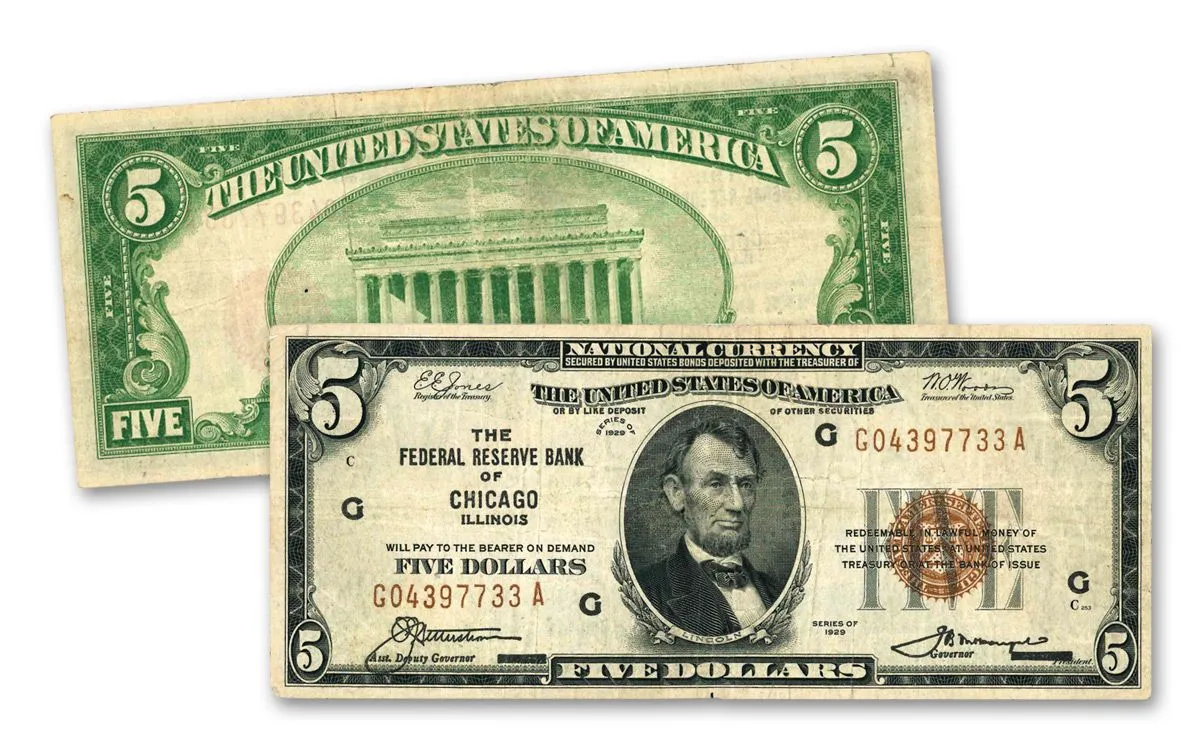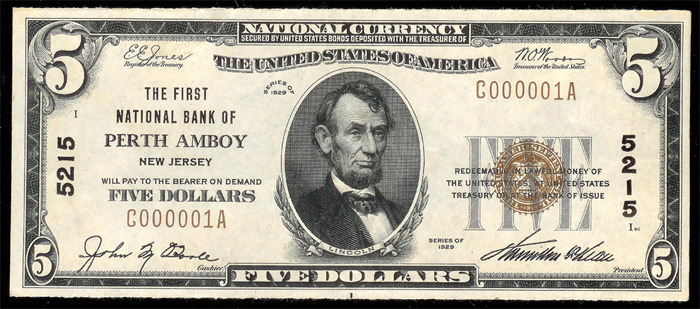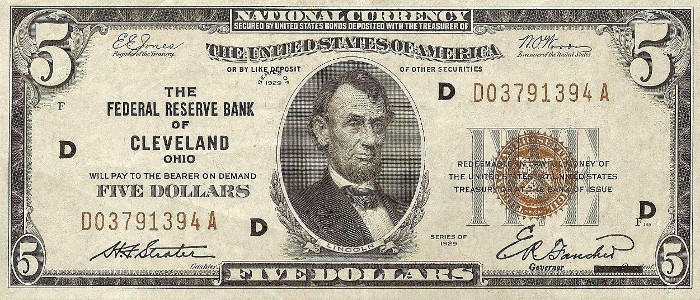The 1929 $5 bill, often sought after by collectors, has a fascinating history and value that varies based on certain features. If you’re wondering, “1929 5 dollar bill value?”, there are several factors to consider, including the bill’s condition, the Federal Reserve Bank that issued it, and specific features like serial numbers and errors.
This article explores the different aspects of the 1929 five dollar bill, its various types, and what factors influence its value in the market today.
1929 5 Dollar Bill Overview
The 1929 five dollar bill is an interesting piece of U.S. currency. It was part of the series issued after the change in design that occurred in the late 1920s. The $5 bill from this period features a portrait of Abraham Lincoln on the front and a variety of distinctive markings and seals.

Understanding the specific attributes of the bill can help collectors determine its value, whether it’s a Federal Reserve Note or a National Bank Note.
The average 1929 five dollar bill, especially those from The Federal Reserve Bank of Philadelphia, in typical circulated condition, is worth around $15. However, certain elements make some of these bills significantly more valuable. If you are holding a 1929 $5 bill and wondering about its worth, it’s essential to examine a few key characteristics that could increase its value.
Federal Reserve Bank Notes vs. National Bank Notes
When it comes to the 1929 five dollar bill, there were two main categories: Federal Reserve Bank Notes and National Bank Notes. The difference between these two types is subtle, yet important.
- Federal Reserve Bank Notes: These bills were issued by the Federal Reserve Banks, and they feature a seal in brown ink and a serial number that begins with the letter “C.” These notes are typically more common, but they can still fetch a reasonable price depending on their condition.
- National Bank Notes: These notes are issued by National Banks and were also printed in 1929. There are two distinct types of National Bank Notes. Type 1 bills are similar to the Federal Reserve Bank Notes, but Type 2 bills include the bank charter number on both the lower left and upper right corners of Abraham Lincoln’s portrait. National Bank Notes from the 1929 series tend to have a slightly higher value, especially for well-maintained bills.
Factors That Affect the Value of the 1929 $5 Bill
While the base value of a 1929 five dollar bill may be relatively low, several factors can increase its worth significantly. Below, we discuss some of the most important elements to consider when assessing the value of a $5 bill from 1929.
1. Condition of the Bill
The condition of the bill plays a huge role in determining its value. Currency is graded on a scale ranging from “Very Fine” to “Uncirculated.”
A bill in “Very Fine” condition has been in circulation but not for a long period, meaning it retains its crispness with minimal creases or smudges.
A bill in “Uncirculated” condition, often rated with an MS 63 grade, has never been used in circulation and still appears crisp and fresh.
- Very Fine Condition: Most 1929 series $5 Federal Reserve Bank Notes are worth around $62.50 in very fine condition.
- Uncirculated Condition: If a bill is uncirculated and graded at MS 63, it could be worth around $185.
2. Special Serial Numbers
Some 1929 five dollar bills have serial numbers that are more unique and rare, which can increase their value.
- Star Notes: Star notes are special because the serial number ends with a star symbol rather than the letter “A.” For instance, if a 1929 $5 bill has a serial number ending with a star, it is considered more valuable. These star notes are extremely rare, with only around two dozen known to exist for the five dollar denomination from the Federal Reserve Bank of Philadelphia. These bills could be worth at least $150 or more.
- Leading Zeros: Another key feature that adds value is when the serial number has six or seven leading zeros. Such bills are rarer and could attract a higher price in the market.
- Consecutive Serial Numbers: Bills with consecutively numbered serial numbers are more valuable than those that are simply circulated. Collectors are often willing to pay a premium for these types of notes.
3. Star Notes vs. Regular Notes
Star notes from the 1929 $5 bill series are rare and much sought after in the market. As mentioned earlier, these bills have a star symbol replacing the final letter in the serial number, indicating they were issued to replace damaged or defective notes.
These notes are often in better condition, and because they were produced in limited numbers, their value can be significantly higher than that of regular notes.
4. Federal Reserve Bank and Location
The location from which the bill was issued also affects its value. Some Federal Reserve Banks, like those in Minneapolis, St. Louis, and San Francisco, tend to issue notes that are more valuable. This is due to the relative scarcity of these notes, making them more desirable to collectors. These bills might be worth more than the average 1929 $5 bills.
Value of 1929 Five Dollar Bills: A Breakdown
When assessing the worth of a 1929 five dollar bill, it’s important to consider the specific type of bill and its condition.

Federal Reserve Bank Notes:
- In very fine condition: Around $62.50
- In uncirculated condition (MS 63): Around $185
- Rare Star Notes or those with special serial numbers: Higher premiums, often exceeding $150.
National Bank Notes:
- Type 1 bills in very fine condition: Around $90
- Type 1 bills in uncirculated condition: Around $200
- Type 2 bills in very fine condition: Around $80
- Type 2 bills in uncirculated condition: Around $225
Collectors often pay higher amounts for National Bank Notes, especially those with unique features like consecutive serial numbers or star notes.
Common Errors in 1929 $5 Bills
Some 1929 five dollar bills contain errors that can make them significantly more valuable. If you come across a bill with a printing mistake, such as misaligned printing or incorrect serial numbers, the bill could be worth more than a regular note. These errors are rare, and collectors highly covet them due to their rarity.
How to Protect Your 1929 $5 Bill
If you have a valuable 1929 five dollar bill, it’s essential to take care of it. To maintain its value, consider placing the bill inside a currency holder or protective sleeve to avoid damage. Handling it carefully and storing it in a safe, dry place will ensure that it remains in good condition, preserving its worth for years to come.
Conclusion
In conclusion, if you are wondering about the 1929 5 dollar bill value, it depends on several factors, including the bill’s condition, type, and special characteristics. While most 1929 $5 bills are worth around $15 in average condition, those with special features, such as star notes, leading zeros, or consecutive serial numbers, can fetch much higher prices. The Federal Reserve Bank and National Bank Notes from this series have varying values, and collectors often seek out rare errors for their collections.
Whether you’re a seasoned numismatist or simply curious about the worth of your $5 bill, understanding the key elements that affect its value will help you assess its true worth. The 1929 five dollar bill remains an interesting and valuable piece of history, and with the right features, it can be worth much more than its face value.

